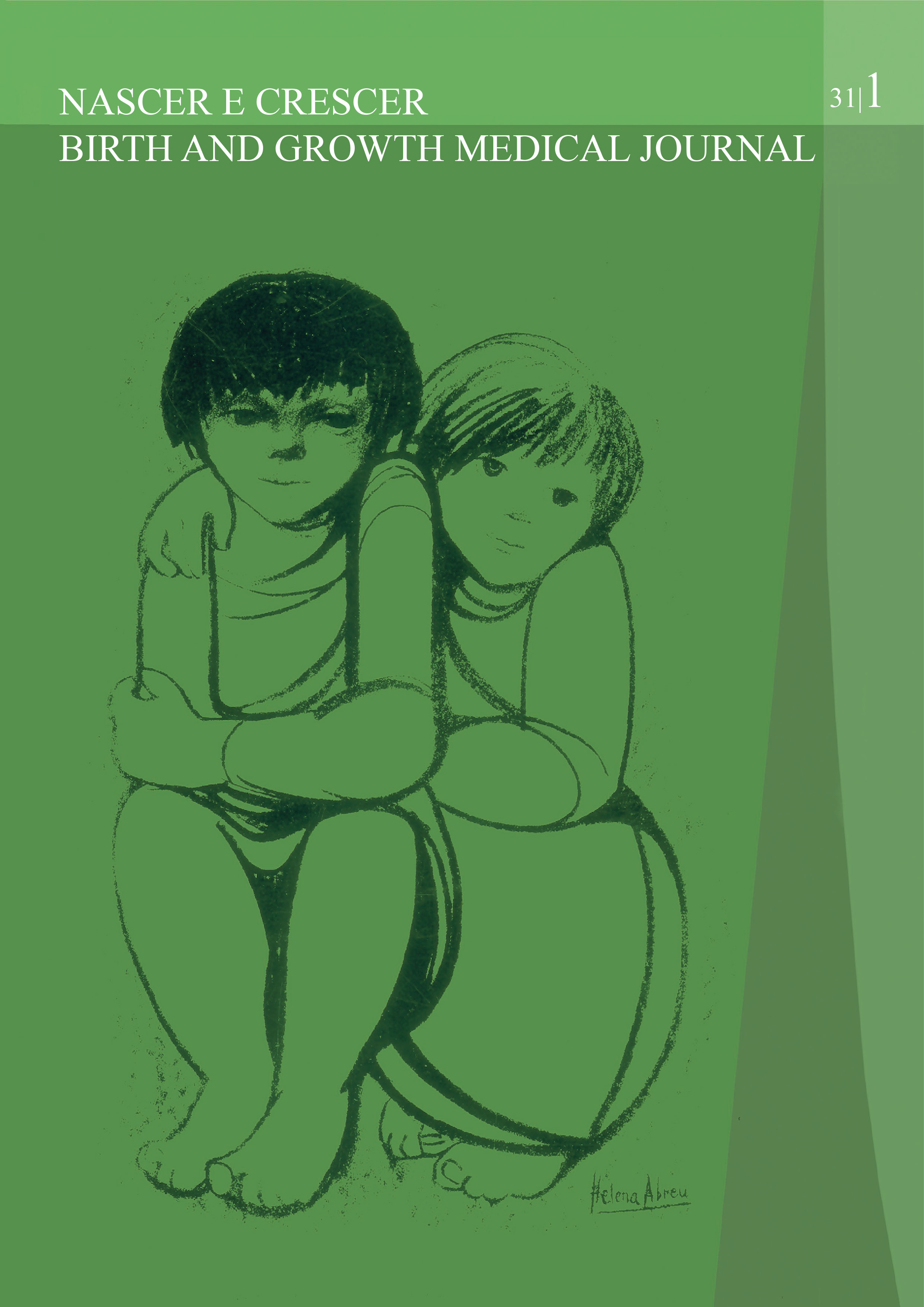Acute Campylobacter spp. gastroenteritis in the Pediatric Emergency Department of a level II hospital
DOI:
https://doi.org/10.25753/BirthGrowthMJ.v31.i1.20981Keywords:
Campylobacter, child, acute gastroenteritis, hygieneAbstract
Introduction: Campylobacter spp. is the main cause of pediatric acute bacterial gastroenteritis (ABG) in the European Union, with greater incidence in children under five years old. Most patients present complete recovery within days of infection, with no associated comorbidities. Antibiotic therapy should be reserved for severe cases.
Objectives: The aim of this study was to investigate the epidemiology, symptoms, treatment, and complications of Campylobacter spp. infection in pediatric patients with ABG.
Material and methods: Case-by-case review of the clinical records of patients evaluated in the Pediatric Emergency Department of a level II hospital with a diagnosis of ABG and Campylobacter spp. isolated from stool samples over a five-year period (2013-2017).
Results: Of the 1990 stool tests performed, 637 (32%) were positive for the presence of bacteria. Campylobacter spp. was identified in the samples of 459 patients (72%). Eighteen patients were excluded for insufficient data, making up a final sample of 441 patients, with a mean age of three years old. Clinically, patients presented with aqueous diarrhea (59.6%), bloody diarrhea (43.8%), bloody and mucus diarrhea (15.4%), mucus diarrhea (3.9%), vomiting (36.3%), abdominal pain (24.3%), fever (63%), seizures (0.9%), and rash (0.2%). Eighty-nine patients were hospitalized. Eleven patients received antibiotic therapy.
Discussion: This study represents the largest national case-by-case review of ABG by Campylobacter spp. in the pediatric population. Campylobacter was the main bacteria identified, mostly associated with self-limited disease.
Conclusion: A judicious use of stool tests allows etiological identification in ABG. The growing number of cases of ABG by Campylobacter spp. reinforces the need for better hygiene procedures.
Downloads
References
Heresi GP, Murphy JR, Cleary TG. Campylobacter jejuni. In: Feigin RD, Cherry JD, Demmler-Harrioson GJ, Kaplan SL, editors. Feigin and Cherry ́s textbook of pediatric infectious diseases. Philadelphia: Saunders Elsevier; 2009. p. 1612-8.
EFSA (European Food Safety Authority), ECDC (European Centre for Disease Prevention and Control). The European Union summary report on trends and sources of zoonoses, zoonotic agents and food-borne outbreaks in 2011. EFSA J 2013;11:3129-250.
Guarino A, Albano F, Ashkenazi S, Gendrel D, Hoekstra JH, Shamir R, et al. European Society for Paediatric Gastroenterology, Hepatology, and Nutrition/European Society for Paediatric Infectious Diseases evidence- based guidelines for the management of acute gastroenteritis in children in Europe. J Pediatr Gastroenterol Nutr 2008;46:S81-122.
European Centre for Disease Prevention and Control. Annual epidemiological report: Campybacteriosis. 2016. (Accessed on April 25, 2018). Available in: https://www.ecdc.europa.eu/en/publications-data/campylobacteriosis-annual-epidemiological-report-2016-2014-data.
Duarte A, Santos A, Benoliel J, Domingues F, Oleastro M. A infeção humana por Campylobacter em Portugal: alguns dados epidemiológicos. Instituto Nacional de Saúde Doutor Ricardo Jorge. Infeções Gastrointestinais. Artigos breves nº7. 2013.
Ketley JM. Pathogenesis of enteric infection by Campylobacter. Microbiology 1997;143:5-21.
Murray PR, Rosenthal KS, Pfaller, MA. Medical microbiology. 5th. Philadelphia: Mosby Elsevier; 2005. p.14.
Borges AC, Pedrosa C, Santos A, Vitorino M, Costa M, Godinho C. Campylobacter jejuni: gastrenterites agudas e infecções extra-intestinais. Acta Pediatr Port 2005;36:191-3.
Rodrigues F, Calvino J, Alves AF, Lemos L. Diarreia aguda por Campylobacter spp. Acta Pediatr Port 2006;37:91-4.
Ban M Allos. Clinical manifestations, diagnosis, and treatment of Campylobacter infection. 2019. (Accessed on August 20, 2018). Available in: http://www.uptodate.com.
Paiva M, Santos F, Amaral JMV. Gastroenterite aguda. In: Amaral JV, editor. Tratado de Clínica Pediátrica. Lisboa: Abbott Lda; 2008. p. 532-6.
Bhutta ZA. Acute gastroenteritis in children. In: Kliegman RM, Stanton BF, Schor NF, Geme JW, Behrman RE, editors. Nelson Textbook of Pediatrics. Philadelphia: Elsevier Saunders; 2011. p. 1323-38.
Peixoto AMM, Brett ACO, Rodrigues FMP. Gastroenterite Aguda Bacteriana num Serviço de Urgência Pediátrico. Faculdade de Medicina da Universidade de Coimbra. 2016.
Soares AT, Couto C, Romão P, Melo IS, Braga M, Diogo J, et al. Gastroenterite aguda por Campylobacter spp: casuística de uma urgência pediátrica. Acta Med Port 2014;27:556-60.
Escobar C, Silva T, Costa B, Oliveira M, Correia P, Ferreira GC, et al. Gastroenterite aguda em crianças internadas na área de Lisboa. Acta Pediatr Port 2013; 44:148-55.
Tam CC, O’Brien SJ, Tompkins DS, Bolton FJ, Berry L, Dodds J, et al. Changes in causes of acute gastroenteritis in the United Kingdom over 15 years: microbiologic findings from 2 prospective, population-based studies of infectious intestinal disease. Clin Infect Dis 2012;54:1275-86.
Lengerh A, Moges F, Unakal C, Anagaw B. Prevalence, associated risk factors and antimicrobial susceptibility pattern of Campylobacter species among under five diarrheic children at Gondar University Hospital, Northwest Ethiopia. BMC Ped 2013;13:82.
Adedayo O, Kirkpatrick BD. Campylobacter jejuni infections: update on presentation, diagnosis, and management. Hosp Physician 2008;44:9-15.
Downloads
Published
How to Cite
Issue
Section
License
Copyright (c) 2022 Liliana Sá, Teresa Pinheiro, Joana Silva, Adriana Pedrosa, Laura Soares, Miguel Costa, Cristina Rocha

This work is licensed under a Creative Commons Attribution-NonCommercial 4.0 International License.
Copyright and Authors' Rights
All articles published in Nascer e Crescer - Birth and Growth Medical Journal are Open Access and comply with the requirements of funding agencies or academic institutions. For use by third parties, Nascer e Crescer - Birth and Growth Medical Journal adheres to the terms of the Creative Commons License "Attribution - Non-Commercial Use (CC-BY-NC)".
It is the author's responsibility to obtain permission to reproduce figures, tables, etc. from other publications.
Authors must submit a Conflict of Interest statement and an Authorship Form with the submission of the article. An e-mail will be sent to the corresponding author confirming receipt of the manuscript.
Authors are permitted to make their articles available in repositories at their home institutions, provided that they always indicate where the articles were published and adhere to the terms of the Creative Commons license.


